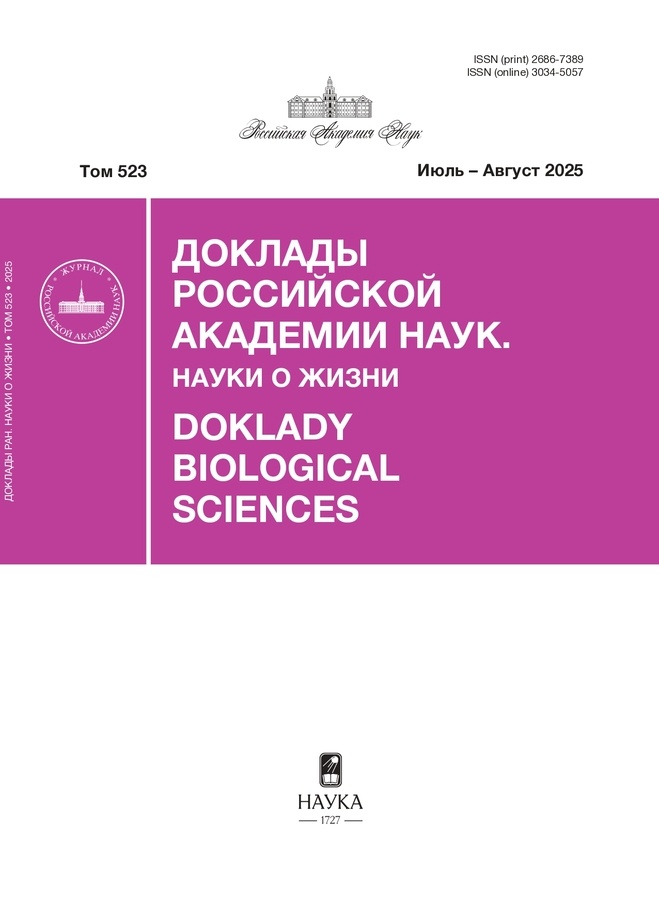Влияние 24-эпибрассинолида и его конъюгата с янтарной кислотой на устойчивость растений рапса к хлоридному засолению
- Авторы: Коломейчук Л.В.1, Литвиновская Р.П.2, Хрипач В.А.2, Кузнецов В.В.1,3, Ефимова М.В.1
-
Учреждения:
- Национальный исследовательский Томский государственный университет
- Институт биоорганической химии НАН Беларуси
- Институт физиологии растений им. К.А. Тимирязева Российской академии наук
- Выпуск: Том 521, № 1 (2025)
- Страницы: 260-267
- Раздел: Статьи
- URL: https://vestnik.nvsu.ru/2686-7389/article/view/684071
- DOI: https://doi.org/10.31857/S2686738925020168
- ID: 684071
Цитировать
Полный текст
Аннотация
Впервые показано, что экзогенный 24-эпибрассинолид (ЭБЛ) и синтезированный на его основе конъюгат, представляющий собой 2,3,22,23-тетраэфир ЭБЛ и янтарной кислоты, в концентрации 10 нМ практически в равной степени смягчают негативные последствия солевого стресса (150 мМ NaCl) на растения рапса, поддерживая их фотосинтетическую активность и ростовые параметры. Отмечена специфичность действия исследуемых соединений в регуляции устойчивости растений рапса к NaCl. ЭБЛ на фоне хлоридного засоления повышает содержание каротиноидов, активность супероксиддисмутазы и пероксидазы, в то время как конъюгат ЭБЛ повышает только активность пероксидазы. Предобработка растений в течение 4-х часов перед стрессом была эффективнее, чем внесение исследуемых регуляторов одновременно со стрессором.
Полный текст
Об авторах
Л. В. Коломейчук
Национальный исследовательский Томский государственный университет
Автор, ответственный за переписку.
Email: kolomeychuklv@mail.ru
Россия, Томск
Р. П. Литвиновская
Институт биоорганической химии НАН Беларуси
Email: kolomeychuklv@mail.ru
Белоруссия, Минск
В. А. Хрипач
Институт биоорганической химии НАН Беларуси
Email: kolomeychuklv@mail.ru
Белоруссия, Минск
В. В. Кузнецов
Национальный исследовательский Томский государственный университет; Институт физиологии растений им. К.А. Тимирязева Российской академии наук
Email: kolomeychuklv@mail.ru
член-корреспондент РАН
Россия, Томск; МоскваМ. В. Ефимова
Национальный исследовательский Томский государственный университет
Email: kolomeychuklv@mail.ru
Россия, Томск
Список литературы
- Wu, X. Gong, D. Zhao, K. Chen, D. Dong, Y. Gao, Y. Wang, Q. Hao, G. Research and Development Trends in Plant Growth Regulators. // Adv. Agrochem, 2024, vol. 3(1) pp. 99–106.
- Waadt, R., Seller, C.A., Hsu, P.K., Takahashi, Y., Munemasa, S., Schroeder, J. I. Plant hormone regulation of abiotic stress responses. // Nat Rev Mol Cell Biol, 2022, 23(10), pp. 680–694.
- Al-Taey, D.K., Al-Musawi, Z.J., Kadium, S. M. A., Abbas, A. K., Alsaffar, M. F., Mahmood, S. S. Brassinolides’ Function and Involvement in Salt Stress Response: A Review. // In IOP Conference Series: Earth and Environmental Science, 2024, vol. 1371(4), P. 042032.
- Garrido-Auñón, F., Puente-Moreno, J., García-Pastor, M.E., Serrano, M., Valero, D. Brassinosteroids: An Innovative Compound Family That Could Affect the Growth, Ripening, Quality, and Postharvest Storage of Fleshy Fruits. // Plants, 2024, vol. 13(21), P. 3082.
- Zajączkowska M., Pacholczak A. Effect of brassinosteroids on rooting of the ornamental deciduous shrubs. // Acta Scientiarum Polonorum Hortorum Cultus, 2024, vol. 23(1), pp. 51–62.
- Yang, Y., Chu, C., Qian, Q., Tong, H. Leveraging brassinosteroids towards the next Green Revolution. // Trends in Plant Science, 2024, vol. 29(1), pp. 86–98.
- Litvinovskaya, R.P., Minin M.E., Raiman, G.A., Zhilitskaya, A.L., Kurtikova, K.G., Kozharnovich, Derevyanchuk, M.V., Kravets, V.S., Khripach V.A., Indolyl-3-acetoxy derivatives of brassinosteroids: synthesis and growth-regulating activity. // Chem Nat Compd, 2013, Vol. 49, pp. 478–485.
- Litvinovskaya, R.P., Vayner, A.A., Zhylitskaya, H.A., Kolupaev, Yu.E., Savachka, A.P., Khripach V.A., Synthesis and stress-protective action on plants of brassinosteroid conjugates with salicylic acid. // Chem Nat Compd., 2016, Vol. 52, pp. 452–457.
- Арчибасова, Я.В., Литвиновская, Р.П., Влияние эпибрассинолида и его конъюгатов с серной кислотой на рост и солеустойчивость Helianthus annuus L. // Вісник харківського національного аграрного університету. Серія біологія (The bulletin of kharkiv national agrarian university. Series biology), 2021, T. 2(53), сс. 41–52.
- Хомюк, Я.В., Артемук, Е.Г., Литвиновская, Р.П. Влияние эпикастастерона и его конъюгатов с кислотами на морфометрические и физиолого-биохимические параметры Trifolium prаtense L. // Веснік Брэсцкага ўніверсітэта. Серыя 5. Біялогія. Навукі аб зямлі, 2022, № 2/20, сс. 52–62.
- Литвиновская, Р.П., Манжелесова, Н.Е., Савочка, О.П., Хрипач, В.А. Синтез тетрагемисукцинатов брассиностероидов и их влияние на начальный рост растений ярового ячменя. // Биоорганическая химия, 2022, T. 48(3), pp. 352–356.
- Lichtenthaler, H.K. Chlorophylls and carotenoids: pigments of photosynthetic biomembranes. // Meth. Enzymol., 1987, vol., 148, pp. 350–382.
- Bates, L.S., Waldran, R.P., Teare, I.D., Rapid determination of free proline for water stress studies. // Plant and Soil, 1973, vol. 39, pp. 205–208. https://doi.org/10.1007/BF00018060
- Buege J.A., Aust S.D. Microsomal lipid peroxidation // Methods Enzymol. 1978. V. 52. P. 302–310.
- Beauchamp, Ch., Fridovich, I. Superoxide dismutase improved assays and an assay applicable to acrylamide gels. // Anal. Biochem., 1971, vol. 44, pp. 276–287.
- Ridge, I., Osborne, D.J. Role peroxidase when hydroxyprolin-rich protein in plant cell wall is increased by ethylene. // Nature New Biol, 1971. vol. 229, 205–208
- Esen, A. A simple method for quantitative, semiquantitative, and qualitative assay of protein. // Anal. Biochem., 1978, vol. 89., pp. 264–273.
- Garcia-Caparros, P., De Filippis, L., Gul, A., Hasanuzzaman, M., Ozturk, M., Altay, V., Lao, M. T. Oxidative stress and antioxidant metabolism under adverse environmental conditions: a review. // The Botanical Review, 2021, vol. 87, pp. 421–466.
- Hasanuzzaman, M., Bhuyan, M. B., Zulfiqar, F., Raza, A., Mohsin, S. M., Mahmud, J. A., Fyjita M., Fotopoulos, V. Reactive oxygen species and antioxidant defense in plants under abiotic stress: Revisiting the crucial role of a universal defense regulator. // Antioxidants, 2020, vol. 9(8), p.681.
Дополнительные файлы















